Meso-Scale Breakage Characteristics of Recycling Construction and Demolition Waste Subgrade Material Under Compaction Effort
Abstract
1. Introduction
2. Materials and Methods
2.1. Raw Materials
2.2. Compaction Test
2.3. Sieve Test After Compaction Test
2.4. Discrete Element Method Simulation of Compaction Test
2.4.1. Numerical Model
2.4.2. Contact Models and Parameter Calibration
2.4.3. Load Application Method and Data Monitoring
3. Results and Analysis
3.1. Impact of Mixing Ratio on Optimum Moisture Content and Maximum Dry Density of CDW Fillers
3.2. Variation in Fractal Dimension and Particle Breakage Index of CDW Fillers Before and After Compaction Test
3.3. Meso-Scale Analysis of Compression Deformation During Compaction
3.4. Meso-Scale Analysis of Particle Breakage Characteristics
4. Conclusions
Author Contributions
Funding
Institutional Review Board Statement
Informed Consent Statement
Data Availability Statement
Conflicts of Interest
References
- Behera, M.; Bhattacharyya, S.K.; Minocha, A.K.; Deoliya, R.; Maiti, S. Recycled aggregate from C&D waste & its use in concrete—A breakthrough towards sustainability in construction sector: A review. Constr. Build. Mater. 2014, 68, 501–516. [Google Scholar]
- Gkyrtis, K.; Pomoni, M. An Overview of the Recyclability of Alternative Materials for Building Surface Courses at Pavement Structures. Buildings 2024, 14, 1571. [Google Scholar] [CrossRef]
- Tabsh, S.W.; Abdelfatah, A.S. Influence of recycled concrete aggregates on strength properties of concrete. Constr. Build. Mater. 2009, 23, 1163–1167. [Google Scholar] [CrossRef]
- Arulrajah, A.; Piratheepan, J.; Disfani, M.M.; Bo, M.W. Geotechnical and Geoenvironmental Properties of Recycled Construction and Demolition Materials in Pavement Subbase Applications. J. Mater. Civ. Eng. 2013, 25, 1077–1088. [Google Scholar] [CrossRef]
- Xue, Y.X.; Arulrajah, A.; Narsilio, G.A.; Horpibulsuk, S.; Chu, J. Washed recycled sand derived from construction and demolition wastes as engineering fill materials. Constr. Build. Mater. 2022, 358, 129433. [Google Scholar] [CrossRef]
- Rondinella, F.; Oreto, C.; Abbondati, F.; Baldo, N. Laboratory Investigation and Machine Learning Modeling of Road Pavement Asphalt Mixtures Prepared with Construction and Demolition Waste and RAP. Sustainability 2023, 15, 16337. [Google Scholar] [CrossRef]
- Lopez-Uceda, A.; Agrela, F.; Cabrera, M.; Ayuso, J.; López, M. Mechanical performance of roller compacted concrete with recycled concrete aggregates. Road Mater. Pavement Des. 2018, 19, 36–55. [Google Scholar] [CrossRef]
- Contrafatto, L.; Cosenza, R.; Barbagallo, R.; Ognibene, S. Use of Recycled Aggregates in Road Sub-base Construction and Concrete Manufacturing. Ann. Geophys. 2018, 61, S1. [Google Scholar] [CrossRef]
- Li, Z.; Lv, S.X.; Liu, L.L.; Guo, J.; Liu, T. Compressive Deformation Characteristics of Sintered Loess after Being Saturated with Water. Int. J. Geomech. 2024, 24, 04024177. [Google Scholar] [CrossRef]
- Li, Z.; Ma, J.; Liu, X.Y.; Liu, L.L.; Cai, G.J.; Peng, L.X.; Xiong, H.B. Exploring the temperature, humidity, and deformation characteristics of gravel replacement foundations in seasonally frozen zones: A model testing study. Bull. Eng. Geol. Environ. 2025, 84, 141. [Google Scholar] [CrossRef]
- Liu, X.Y.; Surya, S.C.C.; Cai, G.J.; Liu, L.L.; Liu, S.Y.; Anand, J.P.; Zhang, W.W. Development and validation of a method to predict the soil thermal conductivity using thermal piezocone penetration testing (T-CPTU). Can. Geotech. J. 2022, 59, 510–525. [Google Scholar] [CrossRef]
- Zhang, J.H.; Gu, F.; Zhang, Y.Q. Use of building-related construction and demolition wastes in highway embankment: Laboratory and field evaluations. J. Clean. Prod. 2019, 230, 1051–1060. [Google Scholar] [CrossRef]
- Vieira, C.S.; Pereira, P.M. Use of recycled construction and demolition materials in geotechnical applications: A review. Resour. Conserv. Recycl. 2015, 103, 192–204. [Google Scholar] [CrossRef]
- Katz, A. Properties of concrete made with recycled aggregate from partially hydrated old concrete. Cem. Concr. Res. 2003, 33, 703–711. [Google Scholar] [CrossRef]
- Poon, C.S.; Shui, Z.H.; Lam, L. Effect of microstructure of ITZ on compressive strength of concrete prepared with recycled aggregates. Constr. Build. Mater. 2004, 18, 461–468. [Google Scholar] [CrossRef]
- Shi, C.L.; Wang, Y.; Wu, C.L.; Song, W.Z. Study on the Mechanical Properties and Design Parameters of Floor Slabs Waste Subgrade Filler. Adv. Mater. Sci. Eng. 2022, 2022, 4913825. [Google Scholar] [CrossRef]
- Melbouci, B. Compaction and shearing behaviour study of recycled aggregates. Constr. Build. Mater. 2009, 23, 2723–2730. [Google Scholar] [CrossRef]
- Park, T. Application of construction and building debris as base and subbase materials in rigid pavement. J. Transp. Eng. 2003, 129, 558–563. [Google Scholar] [CrossRef]
- Barbudo, A.; Agrela, F.; Ayuso, J.; Jiménez, J.R.; Poon, C.S. Statistical analysis of recycled aggregates derived from different sources for sub-base applications. Constr. Build. Mater. 2012, 28, 129–138. [Google Scholar] [CrossRef]
- Nataatmadja, A.; Tan, Y. Resilient response of recycled concrete road aggregates. J. Transp. Eng. 2001, 127, 450–453. [Google Scholar] [CrossRef]
- Zhang, J.H.; Ding, L.; Li, F.; Peng, J.H. Recycled aggregates from construction and demolition wastes as alternative filling materials for highway subgrades in China. J. Clean. Prod. 2020, 255, 120223. [Google Scholar] [CrossRef]
- Li, Z.; Liu, L.L.; Yan, S.H.; Zhang, M.K.; Xia, J.J.; Xie, Y.L. Effect of freeze-thaw cycles on mechanical and porosity properties of recycled construction waste mixtures. Constr. Build. Mater. 2019, 210, 347–363. [Google Scholar] [CrossRef]
- Liu, L.L.; Li, Z.; Cai, G.J.; Liu, X.Y.; Yan, S.H. Humidity field characteristics in road embankment constructed with recycled construction wastes. J. Clean. Prod. 2020, 259, 120977. [Google Scholar] [CrossRef]
- Li, Z.; Yan, S.H.; Liu, L.L.; Dai, B.S.; Dong, W.J. Long-Term Deformation Analysis of Recycled Construction Waste Subgrade Filler. Adv. Civ. Eng. 2019, 2019, 5891759. [Google Scholar] [CrossRef]
- Liu, L.L.; Li, Z.; Cai, G.J.; Geng, X.Y.; Dai, B.S. Performance and prediction of long-term settlement in road embankments constructed with recycled construction and demolition waste. Acta Geotech. 2022, 17, 4069–4093. [Google Scholar] [CrossRef]
- Zhang, J.H.; Zhang, A.S.; Huang, C.; Yu, H.Y.; Zhou, C. Characterising the resilient behaviour of pavement subgrade with construction and demolition waste under freeze-thaw cycles. J. Clean. Prod. 2021, 300, 126702. [Google Scholar] [CrossRef]
- Huang, B.J.; Wang, X.Y.; Kua, H.W.; Geng, Y.; Bleischwitz, R.; Ren, J.Z. Construction and demolition waste management in China through the 3R principle. Resour. Conserv. Recycl. 2018, 129, 36–44. [Google Scholar] [CrossRef]
- Li, Z.; Liu, L.L.; Yan, S.H.; Zhang, M.K.; Xie, Y.L. Properties of microscopic particle morphology and particle contact of renewable construction waste mixtures. Constr. Build. Mater. 2019, 207, 190–205. [Google Scholar] [CrossRef]
- Huang, C.; Zhang, J.H.; Zhang, A.S.; Li, J.; Wang, X.Y. Permanent deformation and prediction model of construction and demolition waste under repeated loading. J. Cent. South Univ. 2022, 29, 1363–1375. [Google Scholar] [CrossRef]
- Ding, L.; Zhang, J.H.; Zhou, C.; Han, S.P.; Du, Q.H. Particle breakage investigation of construction waste recycled aggregates in subgrade application scenario. Powder Technol. 2022, 404, 117448. [Google Scholar] [CrossRef]
- Zhang, J.H.; Liu, K.; Peng, J.H.; Yang, H. Under the Single Particle Size of Subgrade Filling Construction and Demolition Waste Breakage Characteristics. J. Beijing Univ. Technol. 2024; online. [Google Scholar]
- Liang, L.J.; Tong, J.S.; Xu, C.J.; Fan, X.Z. Review on shear strength of construction waste reclamation subgrade fillers. J. Civ. Environ. Eng. 2024; online. [Google Scholar]
- Cil, M.B.; Alshibli, K.A. 3D assessment of fracture of sand particles using discrete elementmethod. Geotech. Lett. 2012, 2, 161–166. [Google Scholar] [CrossRef]
- Yu, Y.; Zheng, Y.; Zhao, X.Y. Mesoscale modeling of recycled aggregate concrete under uniaxial compression and tension using discrete element method. Constr. Build. Mater. 2021, 268, 121116. [Google Scholar] [CrossRef]
- Oskooei, P.R.; Mohammadinia, A.; Arulrajah, A.; Horpibulsuk, S. DEM modeling and experimental analysis of the breakage behavior of recycled crushed brick particles. Transp. Geotech. 2021, 30, 100586. [Google Scholar] [CrossRef]
- Wang, X.M.; Xiao, Y.J.; Li, W.Q.; Chen, Y.L.; Meng, F.W. Assessing particle crushing mechanism and optimizing design for recycled aggregates in road bases via a novel particle crushing DEM method. Constr. Build. Mater. 2024, 438, 137046. [Google Scholar] [CrossRef]
- Peng, Y.X.; Yu, L.Y.; Qian, J.Y.; Li, W.; Zhang, T.; Zhou, L.J. Dynamic tensile behavior and crack propagation in coral aggregate seawater shotcrete: Experimental investigation and numerical simulation. Cement. Concrete. Comp. 2025, 159, 06010. [Google Scholar] [CrossRef]
- Li, Z.Q.; Nie, L.; Xue, Y.; Li, W.; Fan, K. Model Testing on the Processes, Characteristics, and Mechanism of Water Inrush Induced by Karst Caves Ahead and Alongside a Tunnel. Rock. Mech. Rock. Eng. 2025, 58, 5363–5380. [Google Scholar] [CrossRef]
- Li, W.; Yu, L.; Zhang, T. Quantitative analysis of grain size effect on tensile mechanical behavior of granite based on multi-level force chain networks. Comp. Part. Mech. 2024, 11, 2245–2266. [Google Scholar] [CrossRef]
- Chinese Standard JTG 3430–2020; Test Standards of Soils in Highway Engineering. Ministry of Transport: Beijing, China, 2020.
- Tan, P.; Xiao, Y.J.; Wang, M.; Yang, T.; Zhang, C.C.; Li, W.Q. Insights into particle breakage induced macroscopic and microscopic behavior of railway ballast via DEM. Comput. Geotech. 2025, 182, 107135. [Google Scholar] [CrossRef]
- Zhang, J.H.; Li, J.; Yao, Y.S.; Zheng, J.L.; Gu, F. Geometric anisotropy modeling and shear behavior evaluation of graded crushed rocks. Constr. Build. Mater. 2018, 183, 346–355. [Google Scholar] [CrossRef]
- Einav, I. Breakage mechanics—Part II: Modelling granular materials. J. Mech. Phys. Solids 2007, 55, 1298–1320. [Google Scholar] [CrossRef]
- Hardin, B.O. Crushing of soil particles. J. Geotech. Eng.-ASCE 1985, 111, 1177–1192. [Google Scholar] [CrossRef]
- Liu, H.B.; Zeng, K.F.; Zou, Y. Particle breakage of calcareous sand and its correlation with input energy. Int. J. Geomech. 2020, 20, 04019151. [Google Scholar] [CrossRef]
- Zhang, H.L.; Tang, Y.; Meng, T.; Zhan, L.T. Evaluating the crushing characteristics of recycled construction and demolition waste for use in road bases. Transp. Geotech. 2021, 28, 100543. [Google Scholar] [CrossRef]



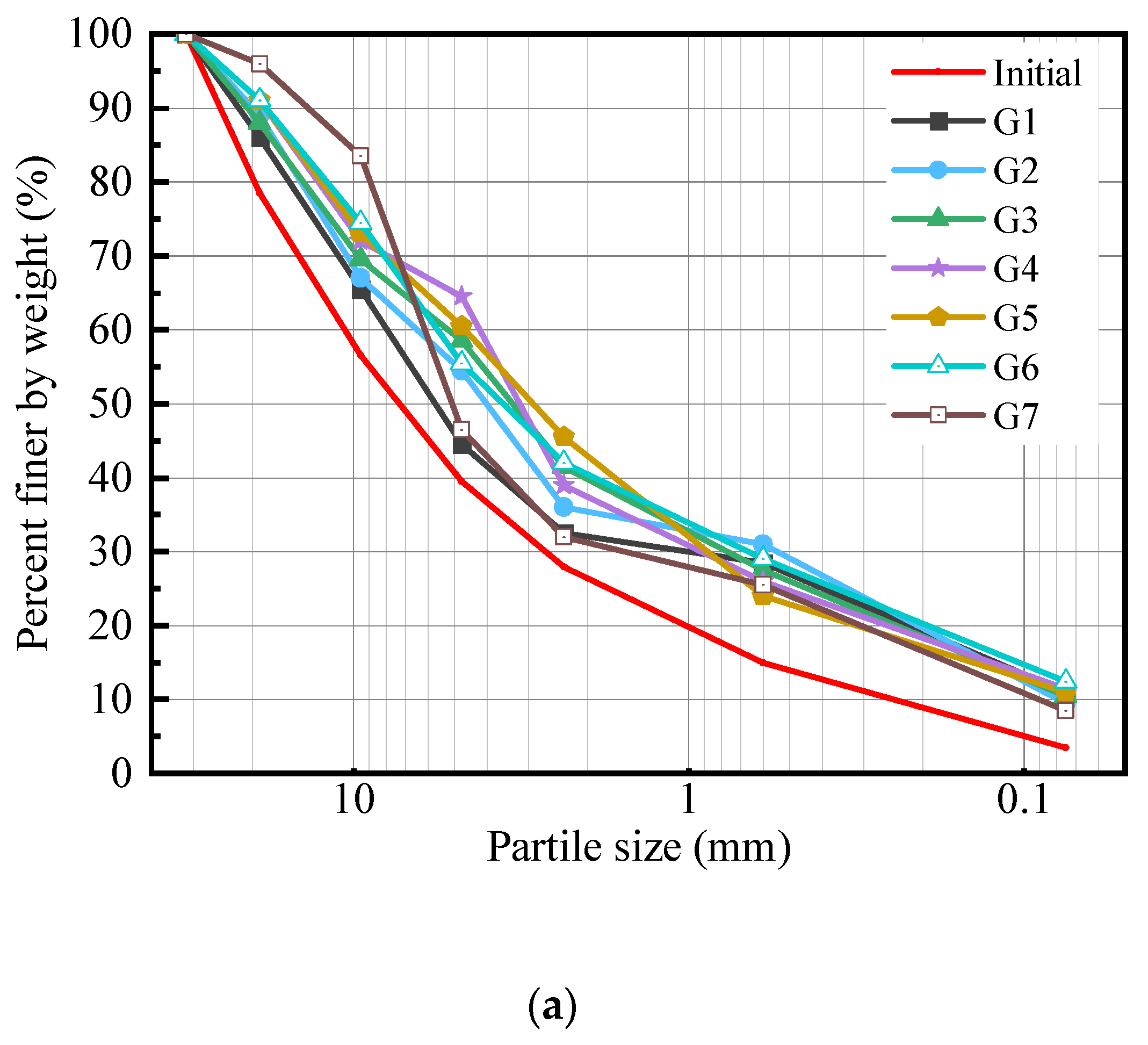
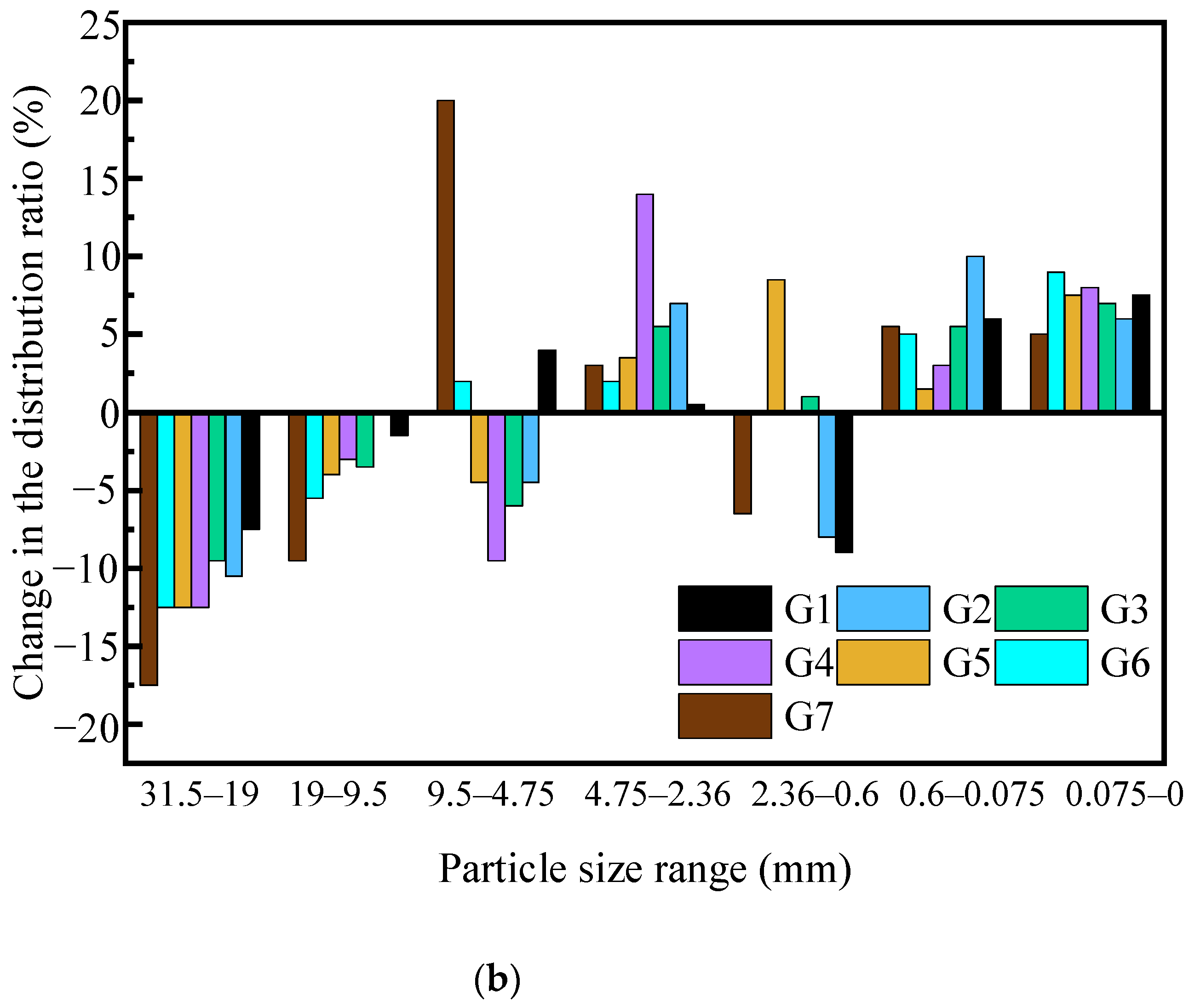
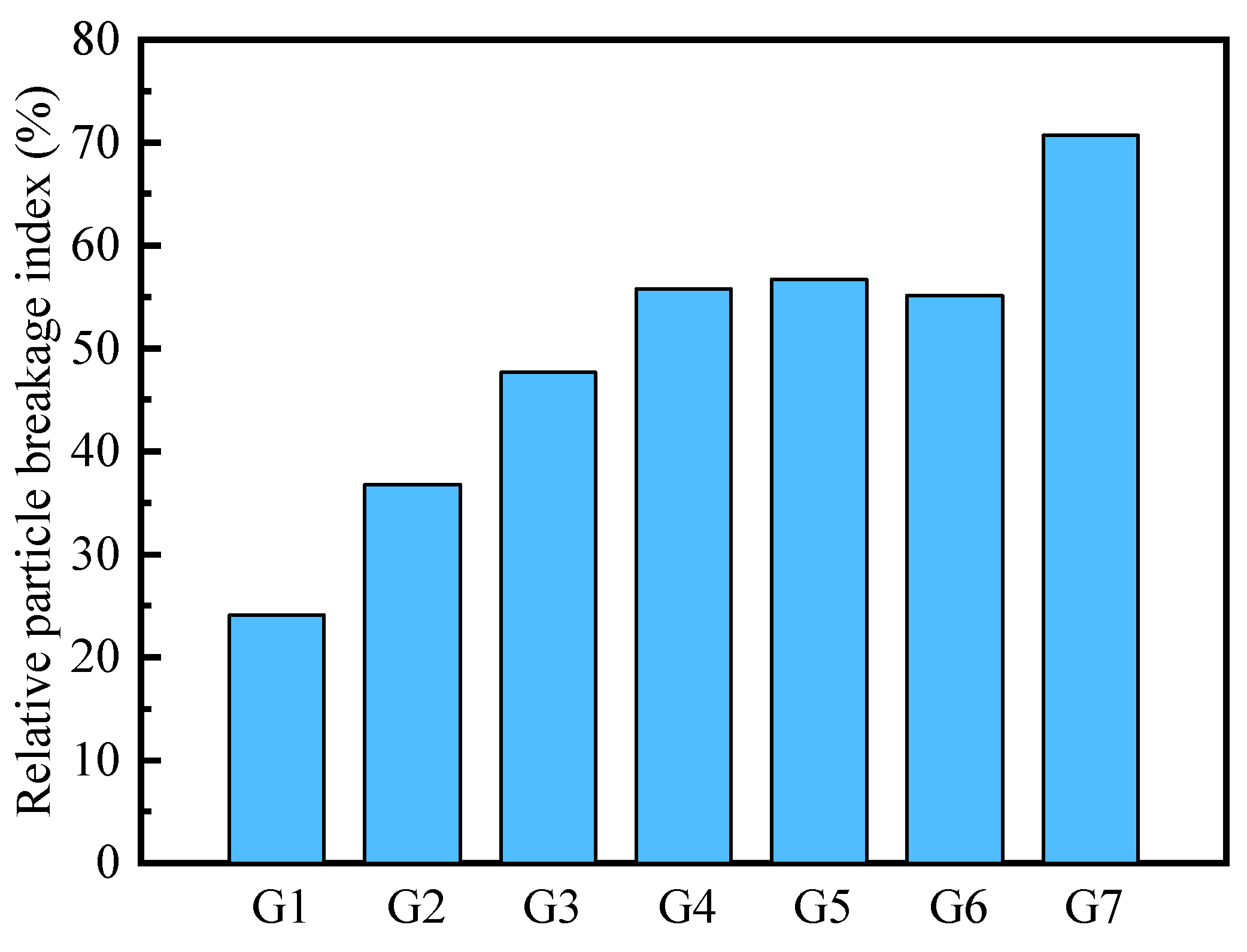




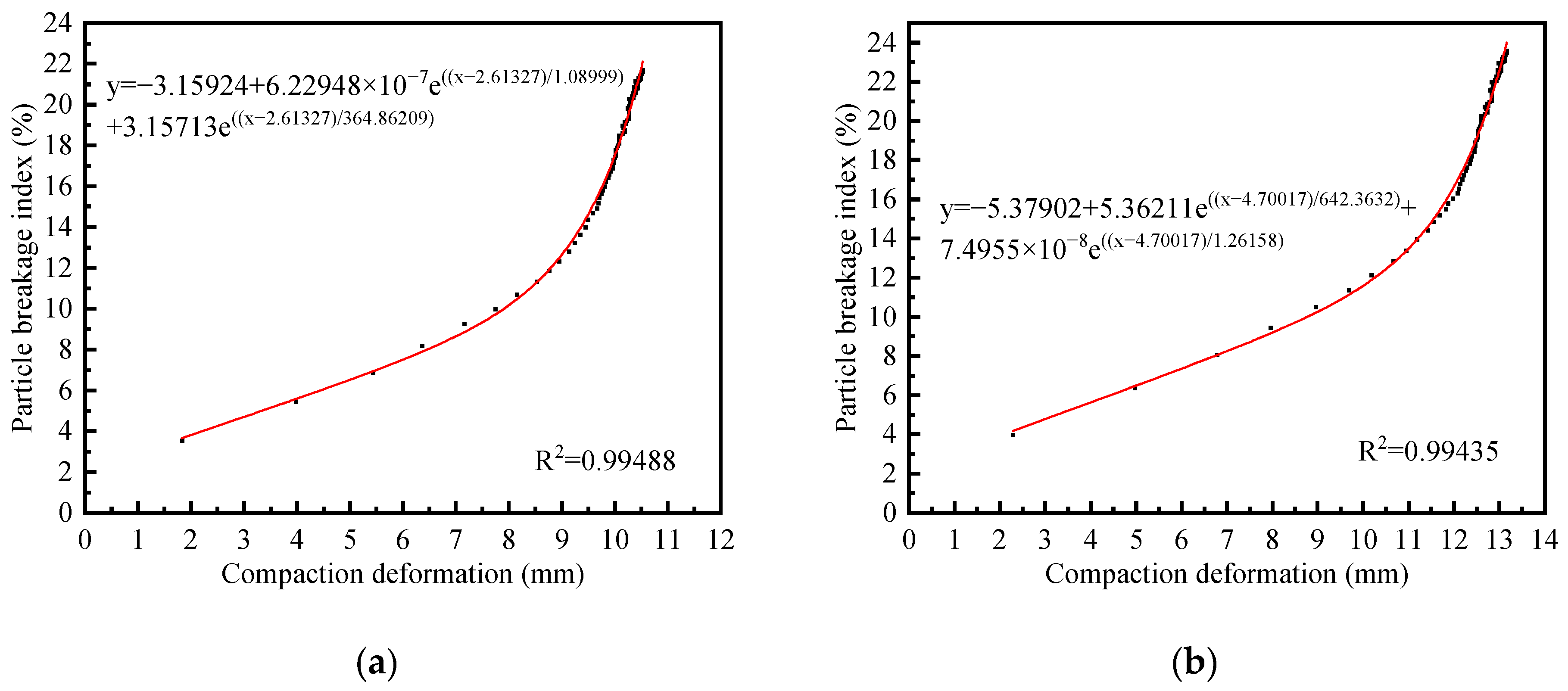
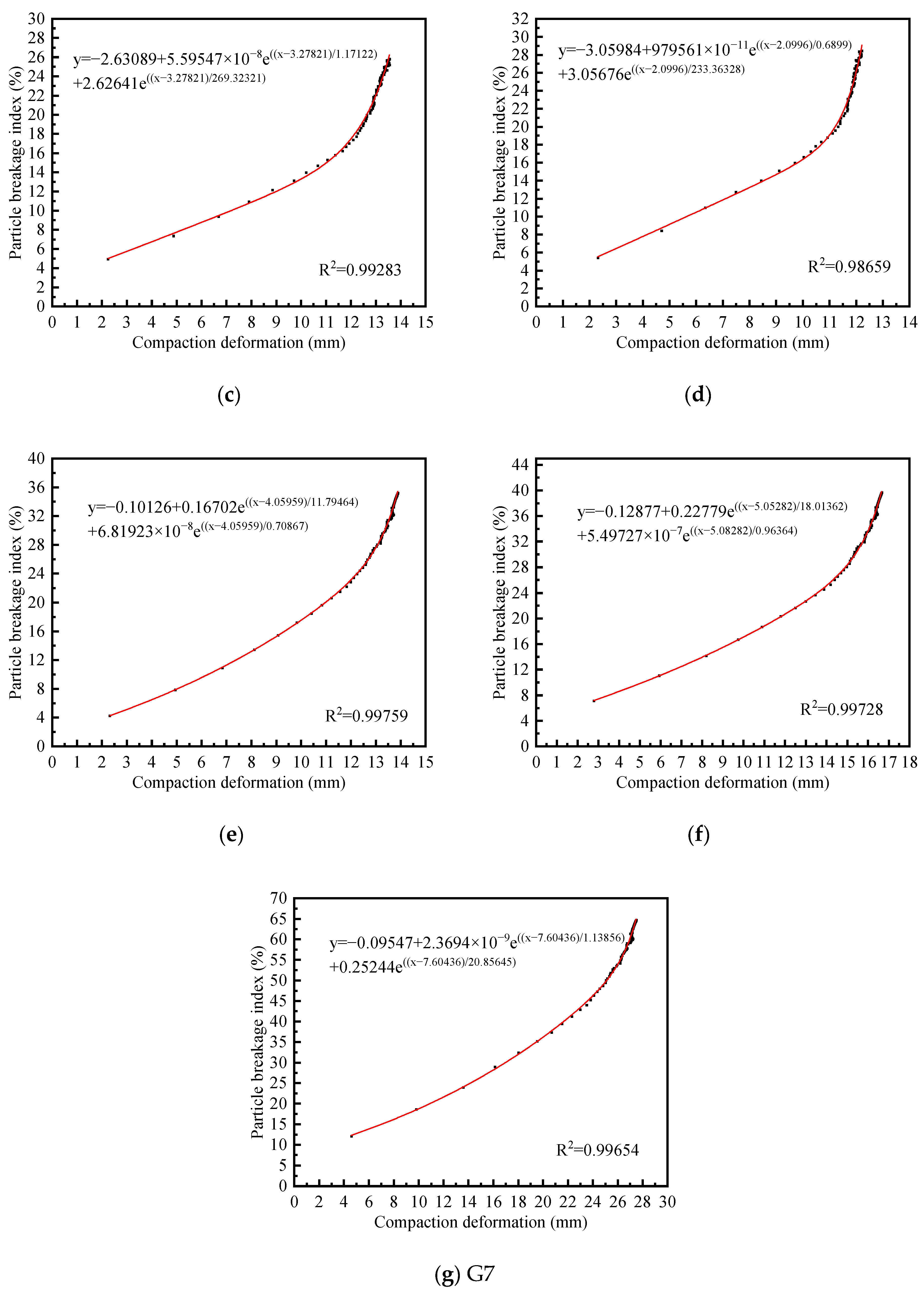
| Raw Materials | Apparent Density (g/cm3) | Packing Density (g/cm3) | Water Absorption Rate (%) |
|---|---|---|---|
| Waste concrete recycled aggregate | 1.32 | 2.32 | 6.9 |
| Waste brick recycled aggregate | 0.81 | 1.74 | 23.1 |
| Group Number | Waste Concrete Recycled Aggregate | Waste Brick Recycled Aggregate |
|---|---|---|
| G1 | 100 | 0 |
| G2 | 90 | 10 |
| G3 | 80 | 20 |
| G4 | 70 | 30 |
| G5 | 60 | 40 |
| G6 | 50 | 50 |
| G7 | 0 | 100 |
| Samples | Effective Modulus (MPa) | Cohesion (MPa) | Tensile Strength (MPa) | Friction Angle (°) |
|---|---|---|---|---|
| Recycled waste brick particles | 100 | 0.4 | 0.3 | 23 |
| Recycled waste concrete particles | 200 | 10 | 8 | 25 |
Disclaimer/Publisher’s Note: The statements, opinions and data contained in all publications are solely those of the individual author(s) and contributor(s) and not of MDPI and/or the editor(s). MDPI and/or the editor(s) disclaim responsibility for any injury to people or property resulting from any ideas, methods, instructions or products referred to in the content. |
© 2025 by the authors. Licensee MDPI, Basel, Switzerland. This article is an open access article distributed under the terms and conditions of the Creative Commons Attribution (CC BY) license (https://creativecommons.org/licenses/by/4.0/).
Share and Cite
Han, L.; Gao, W.; Tao, Y.; Liu, L. Meso-Scale Breakage Characteristics of Recycling Construction and Demolition Waste Subgrade Material Under Compaction Effort. Materials 2025, 18, 2439. https://doi.org/10.3390/ma18112439
Han L, Gao W, Tao Y, Liu L. Meso-Scale Breakage Characteristics of Recycling Construction and Demolition Waste Subgrade Material Under Compaction Effort. Materials. 2025; 18(11):2439. https://doi.org/10.3390/ma18112439
Chicago/Turabian StyleHan, Lu, Weiliang Gao, Yaping Tao, and Lulu Liu. 2025. "Meso-Scale Breakage Characteristics of Recycling Construction and Demolition Waste Subgrade Material Under Compaction Effort" Materials 18, no. 11: 2439. https://doi.org/10.3390/ma18112439
APA StyleHan, L., Gao, W., Tao, Y., & Liu, L. (2025). Meso-Scale Breakage Characteristics of Recycling Construction and Demolition Waste Subgrade Material Under Compaction Effort. Materials, 18(11), 2439. https://doi.org/10.3390/ma18112439






